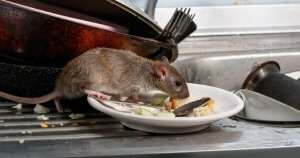Rats in fast-food chains pose serious risks to health and business reputation. Effective rat removal in fast food chains requires a combination of prevention, monitoring, and professional pest control measures to ensure a safe environment. Understanding the common entry points and habits of rats helps you stay ahead in protecting your establishment.
Your fast food chain’s cleanliness and proper waste management are critical factors in deterring rodents. Implementing regular inspections and sealing potential entry points can prevent infestations before they occur. If rats are found, timely removal and ongoing prevention are essential to maintain compliance with health regulations and customer trust.

Understanding Rat Infestations in Fast Food Chains
Rats in food establishments cause serious hygiene and safety problems. Identifying causes, recognizing signs, and understanding operational impacts enable you to manage and prevent infestations effectively.
Common Causes of Rat Problems
Rats are attracted to fast food chains primarily due to easy access to food waste and shelter. Open garbage bins, spilled food, and improperly stored supplies provide a constant source of food.
Structural issues, such as cracks, gaps, or unsealed doors, allow rats to enter freely. Poor sanitation, especially around dumpsters and delivery areas, encourages infestation.
You must also consider employees’ handling of waste and leftover food. Consistent cleaning protocols and sealed food containers help reduce the risk of rats finding and accessing nutrients.
Signs of Rats in Food Establishments
Detecting a rat infestation early is critical. Look for droppings that are small, dark, and pellet-shaped, often near food storage or preparation areas.
Gnaw marks on packaging, wires, or wooden structures indicate the presence of active rats. Nests made from paper or fabric fragments suggest nearby breeding.
You may hear scratching noises at night or notice greasy rub marks along walls where rats repeatedly travel. Unusual odors, described as musky and strong, also point to infestation.
Impact of Rat Infestations on Operations
Rat infestation in food service settings leads to health code violations and potential fines. Customers may lose trust, resulting in decreased sales and damaged reputation.
Rats can contaminate food and surfaces with pathogens, increasing the risk of foodborne illnesses. This creates liability issues and can force temporary closures during pest control.
Maintenance costs rise due to damage caused by gnawing and nesting behaviors. You face increased expenses for repairs, cleanup, and pest control services.

Effective Rat Removal Strategies
Removing rats from fast food chains requires a combination of methods, timely action, and specialized expertise. You must address both the immediate infestation and the factors that attract rodents to your location.
Integrated Pest Management Approaches
Integrated Pest Management (IPM) focuses on combining multiple tactics to control and prevent rat infestations without relying solely on chemicals. Begin by identifying entry points and sealing cracks or holes to block access.
Sanitation is critical. Removing food scraps, properly storing supplies, and maintaining clean waste areas reduce the food sources that attract rats. Using traps strategically, along with careful monitoring, lets you track rodent activity and adjust your approach.
IPM prioritizes long-term prevention through habitat modification and frequent inspections. This method is effective for pest control in quick-service restaurants because it minimizes disruption and environmental impact.
Professional Rodent Control Solutions
Engaging professional rodent control experts is crucial, especially for large or persistent infestations in fast-food chains. They bring specialized tools such as bait stations designed to prevent accidental exposure to customers and staff.
Professionals utilize knowledge of rat behavior and local rodent populations, such as those in Dallas, to tailor treatments. They can perform thorough inspections, implement exclusion techniques, and monitor after treatment to confirm success.
Your partnership with a certified pest control company ensures compliance with health regulations and reduces the risk of recurring infestations. Experienced providers also handle documentation necessary for audits or inspections.
Importance of Fast Response to Infestations
Acting quickly at the first sign of rats is vital. Delays allow populations to grow rapidly, increasing the risk of contamination and potentially causing damage to equipment or structures.
You must train your staff to recognize early indicators, such as droppings, gnaw marks, or sounds. Immediate reporting and fast intervention limit the scale of rodent control needed.
A rapid response prevents reputational harm and potential closures due to health code violations. It also reduces the overall cost of pest control in quick service restaurants by minimizing prolonged treatments.
Prevention and Hygiene Best Practices
Maintaining strict hygiene and implementing effective prevention methods is essential to keep rodents out of fast-food locations. Emphasizing sanitation, staff education, and physical barriers is key to minimizing rat activity and ensuring compliance with fast food hygiene and rodent prevention standards.
Facility Sanitation Measures
You must implement rigorous cleaning routines throughout your facility to reduce food sources that attract rats. Regularly sweep, mop, and sanitize all surfaces, especially those areas behind and under equipment where crumbs tend to accumulate. Store food items in sealed, rodent-proof containers to limit access to them.
Trash management is crucial. Empty bins frequently and use containers with tight-fitting lids to prevent rodents from accessing them. Drainage areas should be clear and dry, as standing water can attract rats and other pests.
Inspect your premises daily for signs of rodent activity, such as droppings or gnaw marks. Promptly repairing any cracks or holes in walls or floors reduces potential entry points, reinforcing your facility’s defenses.
Employee Training and Awareness
Your staff must understand the importance of fast food hygiene and rodent prevention to identify and address early signs of infestation. Provide clear, regular training on food handling, waste disposal, and reporting potential rodent sightings.
Emphasize the importance of consistent cleaning habits, such as wiping down counters after every shift and promptly removing food waste. Encourage employees to notify management immediately if they notice damaged packaging, droppings, or gnawing marks.
A well-informed team serves as a critical line of defense. Document training sessions and maintain checklists to ensure accountability and continuous improvement in rodent prevention practices.
Physical Barriers and Exclusion Techniques
To keep rodents out effectively, install physical barriers and exclusion devices around your fast food location. Use door sweeps and metal kick plates on all entry points to block access.
Seal gaps around pipes, vents, and utility lines with steel wool or metal flashing. Avoid using materials that rats can chew through, such as plastic or rubber.
Storm drains and external garbage areas should have rodent-proof covers. Consider installing rodent guards or mesh screens to prevent rodents from nesting. Combining these measures creates a reliable barrier that supports your overall fast food hygiene and rodent prevention efforts.

Regulatory Compliance and Health Standards
Maintaining strict pest control and health protocols is critical to keep your fast food chain safe and operational. Understanding local regulations and consistently following documentation practices ensures you meet the required standards for restaurant health and pest control in Dallas.
Health Codes for Restaurants in Dallas
Dallas health codes require fast food chains to implement comprehensive pest control programs to prevent rat infestations. Your establishment must comply with Chapter 10 of the Dallas Health Code, which mandates regular sanitation, food storage practices, and structural maintenance to eliminate rodent access.
Key points include:
- Secure trash disposal: Waste bins must be tightly sealed and emptied frequently.
- Food storage: All food products should be stored off the floor and covered to prevent contamination.
- Building maintenance: Sealing cracks and holes in walls, doors, and windows is necessary to block rodent entry.
Failing to meet these standards can result in fines or closure. You are responsible for proactive measures that align with Dallas city requirements to protect public health and your business reputation.
Routine Inspections and Documentation
Routine pest inspections are essential in maintaining compliance with Dallas restaurant health regulations. You should schedule inspections both internally and with local health authorities to identify early signs of rodent activity.
Adequate documentation of these inspections includes:
| Documentation Element | Purpose |
|---|---|
| Inspection dates | Track frequency and compliance |
| Findings | Note rodent signs or related issues |
| Corrective actions | Detailed steps taken to address problems |
Keeping detailed records proves your commitment to pest control and supports continual improvement. If rat problems arise, these documents help you take swift, documented action to resolve issues before they escalate.
For expert assistance in rat removal and pest management tailored to your fast food chain, call Critter Stop at (214) 234-2616 for a free inspection. Critter Stop is trusted across Dallas for delivering efficient, humane wildlife removal with exceptional quality and customer care.
—

